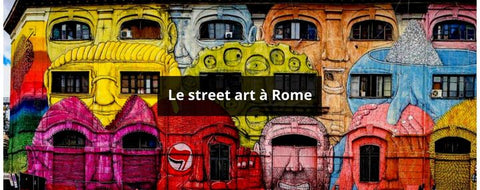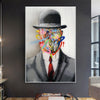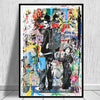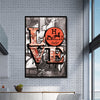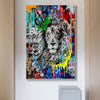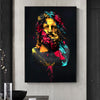
Banksy's Cardinal Sin
Are you passionate about contemporary art? That's only natural when you're aware of its beauty and depth. As you probably know, Banksy , although he didn't create the movement, is the undisputed star of street art.
His talent, passion, and above all, his outspokenness have made him one of the most renowned contemporary artists . His works (stencils, installations, paintings, and sculptures) resonate across all continents. He uses them to support causes, denounce abuses, and convey political or religious messages . This is the case with his work titled Cardinal Sin. Drawing on our experience with Banksy's work, we'll tell you everything that lies behind this famous sculpture.
In the rest of this article, we will talk about:
- Banksy's interest in religion and the exact meaning of Cardinal Sin
- From Cardinal Sin to Moco Amsterdam
- In the way that Banksy combined sculpture with street art.
By the end of this article, you will be able to better understand what Banksy thinks about religion , what prompted him to make a name for himself in sculpture, and you will know everything there is to know about Cardinal Sin.

I) Banksy's Cardinal Sin, the meaning
Cardinal Sin is simply one of Banksy's most satirical creations . It has been considered by many to be highly scandalous and provocative. You're probably wondering why. It's simple: Cardinal Sin is actually a replica of an 18th-century bust. It depicts the face of an influential member of the Catholic Church . Its distinctive feature is that Banksy chose to highlight the face with a mosaic of ceramic tiles.
Banksy created this work to protest the scandals of child abuse suffered by several Catholic priests . The abuse allegedly went on for several years and was covered up and suppressed by the Church.
The work was deemed provocative for several reasons. First, it should be noted that it was unveiled on the eve of Christmas 2011. Second, the sculpture itself contains a rather ironic play on words: "Cardinal Sin," which can be translated as " cardinal sin " or " mortal sin ." Finally, the most striking aspect of the exhibition was that it was displayed for the very first time in history at the Liverpool Walker Art Gallery , in the room housing exceptional 17th-century Christian art: an altarpiece that Murillo painted in 1673 for the Archbishop of Seville, as well as religious paintings by Rubens.

A) Banksy and religion
Banksy's works touch on diverse fields. He simply needs to focus on a particular area for him to act in his own unique way. Religion is no exception to this rule he holds dear. His works related to religion embody the fractured relationship between contemporary Western society and Christianity. Through his art, Banksy critiques the place of religion in general, and Christianity in particular, in modern society. He is not the first artist to follow this path; prominent figures like Gordon Lynch have preceded him.
Popular culture as we know it represents an outdated religion that has lost touch with reality. This is obviously a negative message, but constructive criticism like Banksy's is necessary and useful insofar as it allows him to remain relevant.

B) Banksy and the critique of the Church
Controversial works like Banksy's are very often underestimated or misunderstood. When he denounces the failure of religion in its attempt to integrate into a society primarily focused on technology, Banksy may in fact be calling for its defense.
Indeed, this may be a way to motivate the Catholic Church to react and respond appropriately. On the other hand, one wonders if it isn't also a way for him to push society to analyze religion and change its perspective, specifically regarding the hypocrisy surrounding actions at the level of words and empty faith. The images used by Banksy thus serve as a basis for evaluating the true place of religion in society.

The fact that Banksy uses traditional images of Christ on the cross, the Virgin Mary, the infant Jesus, and a pure white dove helps people remember the transition that culture (as we know it today) has undergone in relation to Christianity. While Banksy's actions may offend devout Catholics, they have the advantage of prompting reflection and bringing the question of religion in modern society to the forefront.
II) Cardinal Sin, resident of MOCO Amsterdam
In his early days, Banksy specialized in street art : he created stencil paintings on walls around the world. He also produced some of his works on canvases, some of which sold for record sums. Evolving in his thinking, he has allowed some of his works to be exhibited in galleries and museums , and even to be sold.
A) A Banksy artwork displayed in a museum
As mentioned above, Banksy created Cardinal Sin in 2001. This was a time when suspicions of pedophilia surrounded prominent figures in the Catholic clergy. The artwork in question is a replica of a 17th-century cardinal; in place of his face, there are ceramic squares that evoke pixelation . These are intended to mask or conceal the identity of the person depicted.

This sculpture, like other works by Banksy, was exhibited at Moco . In fact, this museum, which opened on April 9, 2016, is the very first establishment of its kind to host and exhibit the works of the famous Bristol artist.
C) Our opinion on the MOCO
The Modern Contemporary Museum, also known as Moco, is a museum located on Museumplein in Amsterdam. As mentioned earlier, it was the first museum in the world to host a Banksy exhibition.
The museum itself is the brainchild of two gallery owners from the Lionel Gallery (in Amsterdam): Lionel and Kim Logchies. Almost all the works on display come from private collections. Some of them are frequently for sale.
To be more precise, and after visiting it, we can tell you that Moco is located in a building called Villa Alsberg. It's a design that was put together by Eduard Cuypers in 1904. He was none other than the cousin of Pierre Cuypers, the architect responsible for the Rijksmuseum and Amsterdam Central Station.

III) Cardinal Sin, one of Banksy's rare sculptures
As everyone already knows, Banksy specializes primarily in paintings, stencils, and graffiti. He has also created several structures, though these are fewer in number compared to all the artistic achievements of the Bristol graffiti artist .
A) From street art to sculpture
When you look at the work of this talented artist, you can't help but acknowledge that, in both his paintings and sculptures, Banksy consistently manages to captivate his audience with his art. This ability is further amplified by the fact that he is everywhere and nowhere at once, and that no one officially knows his true identity. He goes to great lengths to remain anonymous , and he succeeds brilliantly. As proof (if any were still needed), no one can say for certain who he is, although rumors have circulated about an identity that was perhaps accidentally revealed.
The artist has created several sculptures around the world, which, like the majority of his works, have been very successful. One example is the protester who toppled the statue of the infamous slave trader Edward Colston in Great Britain. They were demonstrating against racism and police brutality. To support their cause, Banksy proposed returning the statue to its original pedestal, attaching a cable around its neck, and commissioning life-size bronze statues of the protesters pulling it down.

B) The Drinker by Banksy
Another Banksy sculpture has also garnered attention: The Drinker. This statue recreates the iconic pose of Auguste Rodin's The Thinker. Displayed in the heart of London in 2004, specifically off Shaftesbury Avenue, it has a rather unique history.

Banksy has had his work stolen twice. The first time, the theft bore the signature of Andy Link, aka AK47. AK47 is an artist who has made stealing other works his specialty. He then resells them for money. So, in 2004, he managed to steal "The Drinker" from Banksy. AK47 then sent a ransom demand to the graffiti artist for the artwork's return; it amounted to £5,000. Banksy humorously responded by saying he was willing to give £2 so the thief could buy petrol to set the statue on fire. Following a prolonged lack of response, AK47 kept the stolen statue and became its new owner.

The first theft was already unusual, but another surprise awaited the public. In a dramatic turn of events, the thief who had installed the statue in his garden had it stolen again in 2007. AK47 naturally filed a complaint, but to no avail, as the artwork had completely vanished. Many months passed before it resurfaced at an auction organized by Sotheby's. Its estimated value ranged from £750,000 to £1,000,000. Unfortunately for AK47, The Drinker will not be the subject of any legal proceedings.
In short, in his paintings as well as his sculptures, Banksy always manages to achieve his goal: to convey messages on themes that are close to his heart while making his audience think, shock, provoke and talk.
C) Cardinal Sin, an innovative artistic creation
To return to Cardinal Sin, since it is the central work of our article, we remind you that it is a reproduction of a bust with a sawn-off face, which has been replaced by several blank tiles. These have created a pixelated effect , as intended by its creator.
This was not a random act, as he did it in response to the scandal involving child abuse in the clergy.
In one of his statements related to this work, Banksy declared :
"I never know who deserves to be put on a pedestal or crushed under a (...) The statue? I suppose you could call it a Christmas present. At this time of year, it's easy to forget the true meaning of Christianity - the lies, the corruption, the abuses."

Reyahn King, director of the National Museums Liverpool art gallery, revealed that the street artist had approached her institution and specifically requested that his sculpture be displayed near the gallery's existing collection of period art. This request was very well received by the management.
She also appreciated the fact that the sculpture concealed a clear and concise message that one had to try to decipher by looking at the pixelated pieces of tile. This had the added benefit of encouraging visitors to observe the other paintings in the gallery , trying to find the hidden messages within them.
Put a Banksy reproduction in your living room
Now you're an expert on Banksy and his famous Cardinal Sin. You can now better decipher Banksy's secrets and discuss them with street art enthusiasts. If you wish, you can viewour most beautiful Banksy paintings .
See you soon.
The Lofty Trend Team.





